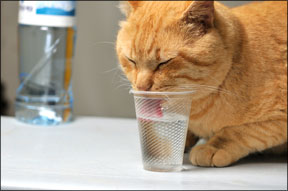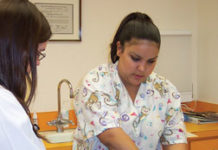Your cats kidneys play a central role in almost all of its bodily processes. They help to control the blood pressure and regulate the amount and chemical consistency of fluid in the bloodstream. They produce a variety of vitally needed hormones and enzymes, and they contribute to the production of red blood 288 cells. They also remove metabolic waste, such as urea, mineral salts and poisonous substances, from its blood. This is accomplished by kidney (renal) tissue containing hundreds of thousands of tiny filtration units called nephrons. When waste-laden blood enters the kidneys through the renal artery, it moves through progressively smaller vessels until it reaches these nephrons, where it is filtered through microscopically minute structures called glomeruli. The cleansed blood – about 95 percent of the total fluid volume that originally entered the kidneys – then circulates back to the heart for yet another voyage through the body. Meanwhile, the remaining fluid, containing the waste products, is passed along as urine from the kidneys to the bladder and eventually excreted. Potential Malfunctions. When the kidneys and their complex filtering system break down, toxic wastes can start to accumulate in the recirculating bloodstream. If a proper balance of waste, minerals and electrolytes (such as sodium and potassium) is not maintained, severe complications may affect other organs. Unfortunately, feline kidneys are susceptible to a wide range of life-threatening disorders that can lead to renal dysfunction and death. Especially in cats that are seven years of age and older, kidney failure is one of the most frequently observed causes of severe illness. A high risk for kidney disease may be inherited, and some veterinary experts contend that long-haired breeds such as Persians and Angoras are more genetically predisposed than short-haired breeds. But the great majority of cases are acquired, and they fall into either of two broad categories: acute and chronic renal failure. The essential difference between the two is that acute renal failure is a severe condition with a relatively sudden onset whose clinical signs become apparent over a period of a week or a month, while chronic renal failure is a disease that has been present for a long time. Common causes of acute renal failure include blockages that interfere with the flow of blood to the kidney or the flow of urine from it. Most common of all causes, however, is the ingestion of substances that are toxic to the kidneys, such as antifreeze, pesticides, cleaning fluids and certain human medications. Consuming a tablet of ibuprofen, for example, can precipitate a severe and quite possibly fatal episode of acute renal failure in a cat. If diagnosed at its earliest stage and treated immediately, kidney damage resulting from acute renal failure is potentially reversible. When treatment is immediately administered, the prognosis for full recovery is excellent, and a cat often can go on to enjoy a normal life span. The same cannot be said for chronic renal failure, which is an incurable condition that mainly afflicts middle-aged and older cats. It occurs when 75 percent or more of functional kidney tissue – that which contains the nephrons – has been destroyed and replaced by scar tissue. Unlike acute renal failure, the onset and progression of this condition – called interstitial nephritis – is gradual, extending over many months or even years. The exact causes of chronic kidney failure are unknown, although the debilitating loss of healthy kidney tissue may be a natural endpoint for several readily recognizable conditions, including advanced dental disease and a variety of kidney infections, inflammations and obstructions. By the time a cat is showing signs of chronic renal failure, the underlying cause is for the most part irrelevant, since the loss of healthy kidney tissue will preclude effective treatment of that cause, whatever it may have been. In some cases, little can be done to prolong the life of a cat diagnosed with late-stage chronic renal failure. On the other hand, it is quite common nowadays – thanks to innovative medical and surgical procedures – for some cats to live for one to three years or even longer following early diagnosis. Signs of Failure. The early indications of failing kidneys include a marked increase in water consumption (polydipsia) and in urination (polyuria); weight loss; apparent decline in appetite; and, in some cases, occasional vomiting. If these signs are observed, the owner should seek veterinary consultation at once. If kidney disease is suspected, a veterinarian will first perform a chemistry panel and a urinalysis. The panel will detect the blood levels of substances that would normally be shed in the urine – especially blood urea nitrogen (BUN) and creatinine. Elevated levels indicate that the kidneys are not adequately filtering these metabolic wastes. The urinalysis will provide additional information on the extent of kidney damage and whether an infection might be responsible for the diminished kidney performance. Further tests – including X-rays, ultrasound and even a kidney tissue biopsy – may be required to confirm a tentative diagnosis of renal failure. Treating the Condition. Treatment for renal failure has traditionally been determined by the type of disorder causing the condition – if the disorder can be identified, that is – and the extent of kidney damage that has been sustained. Acute renal failure, of course, must be given emergency treatment. If caused by any type of urinary-tract blockage, for example, the obstruction must be removed immediately. The use of any suspect medications must cease, and intravenous solution infusions must be administered without delay in order to correct fluid and electrolyte imbalances in the blood. The vast majority of chronic renal failure cases, however, will be addressed with conservative medical measures, the objective of which is to provide palliative treatment. These measures can include intravenous fluid therapy and diet modification, which may slow, but not stop, the loss of kidney function. The diet that is usually recommended for affected cats is low in phosphorus and rich in high-quality proteins (cooked eggs, liver, turkey and so forth) and is sometimes enriched with vitamin D and omega-3 fatty acids. In rare cases, surgical removal of a malfunctioning kidney may be recommended, but only if the remaining organ is strong enough to carry out the many kidney functions by itself.



